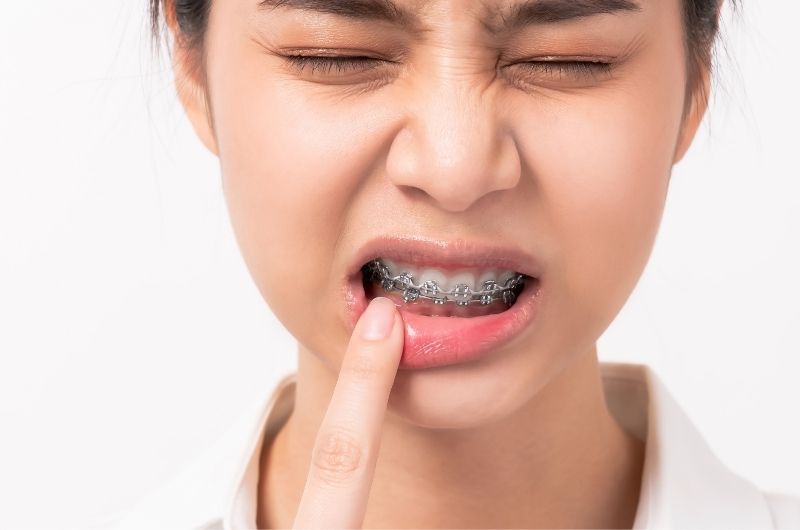When placing braces, an orthodontist typically uses metal or ceramic brackets that are securely attached to the teeth using a special mixture of glue. If your tooth fell out, but it’s still attached to your braces, you should visit your orthodontist as soon as possible to remove the loose tooth. They may reattach the bracket when a new tooth fills in or apply some changes to your braces to take into account the missing tooth. In the meantime, you can help relieve the pain by placing a cold compress on the side of the face where the tooth fell out. If your orthodontist’s office isn’t open, your second option can be to get help at your nearby ER.
What are braces?
At some point in life, you might have met someone who wears braces, or maybe you’ve experienced wearing one set when you were younger.
It’s a common dental device, seen in both children and adults who might have any of the following:
- Problems with the number of their teeth
- Problems in alignment of their teeth
- Misaligned jaws
- Problems with their “bite” (overbite, underbite)
These conditions can cause complications if not treated well!
Other than an unusual physical appearance (often leading to bullying), affected people may constantly feel toothaches and pain and develop tooth decay and stress on the joints used for talking and chewing.
When placing braces, an orthodontist typically uses metal or ceramic brackets that are securely attached to the teeth using a special mixture of glue.
These brackets are then attached to each other through an arch or wire. Small elastics are added to help secure the brackets.
Depending on the dental problem, additional structures may be added, such as coils, elastic power chains, and metal bands.
What happens to my teeth in braces?
Wearing braces may make you feel that your teeth are loosening up. This is because treatment with orthodontics moves your teeth into the proper position.
Along the way, the tooth roots may become shorter or change in length and shape. This is more common in people who have had braces for at least 3 years.
Could a tooth fall out while on braces?
In general, baby teeth will definitely fall out as a child grows. For older children and adults, permanent teeth may also fall out, but because of other poor dental health. Teeth can fall out whether or not they’re on braces, but braces are not a cause for teeth to fall out.
Permanent teeth can fall out for a number of reasons.
1. Tooth hygiene and decay

If you have poor oral hygiene, forgetting to regularly brush your teeth, your teeth and gums are prone to infections that can damage the tooth and loosen its place in the gums.
Tooth decay is also caused by certain dental procedures, like filing, fillings, and crowns.
2. Tooth and gum diseases
Oral cancer and gingivitis are some examples of conditions that can loosen up teeth and cause them to fall out prematurely.
3. Trauma
People who figure in motor accidents or frequently join high-contact sports, such as football and boxing, are prone to tooth trauma.
Some may end up with only a chipped or cracked tooth, while others (unfortunately) lose a tooth or two.
Can I remove a loose tooth from braces?
A loose tooth will most likely still be attached to the bracket or band.
If you notice a loose tooth, the best course of action is to visit your orthodontist as soon as possible to remove the loose tooth.
They may reattach the bracket when a new tooth fills in or apply some changes to your braces to take into account the missing tooth.
It can be hard to find a dentist’s office that can accommodate you if this happens at a late hour.
The next best place to have your teeth checked is the emergency department (ER) at your nearby hospital.
While you’re on the way to the office or clinic, you can help relieve pain by placing a cold compress on the side of the face where the tooth fell out. You can also take over-the-counter painkillers, such as ibuprofen or acetaminophen.
How to take care of teeth with braces
To fend off any other loss of teeth, you should take good care of your teeth and braces.
1. Basic oral care

Brush your teeth regularly: brush in a circular motion twice a day, using fluoride toothpaste, taking at least two minutes per session. Don’t forget to remove the bands first.
2. Extra cleaning matters
Rinse with mouthwash after brushing to help clean up areas that a toothbrush can’t reach well. Flossing will also do wonders on the small cracks and spaces between teeth.
3. Visit your dentist regularly
Don’t delay your next dentist’s appointment. As recommended by your dentist, regular visits are needed to ensure that the braces are placed properly and cleaned correctly.
These sessions are also used to determine if other dental appliances should be added or if your braces may be removed already.
FAQ’s
What are some alternatives to traditional braces?
Metal braces are the most commonly used type of braces. Other types include ceramic braces, invisible braces, and lingual braces.
Removable aligners such as Invisalign may also be a less-invasive alternative. However, not everyone is eligible for these alternatives; your orthodontist will decide which dental appliance is best on a case-to-case basis.
What if the tooth is only chipped or broken?
Try to retrieve the broken piece or pieces. Sometimes, small pieces may remain in the mouth; quickly rinse with water to remove these from the mouth.
Visit your dentist as soon as you can; in some cases, these chipped bits may still be reattached.
Takeaway
Braces are used to help realign any misaligned or crooked teeth and correct an overbite or underbite.
Both baby teeth and adult or permanent teeth may fall out in people, whether wearing braces or not. When a tooth falls out, it is likely still attached to the brace.
Visit your dentist as soon as possible to have the tooth removed and readjust the brace if needed.


